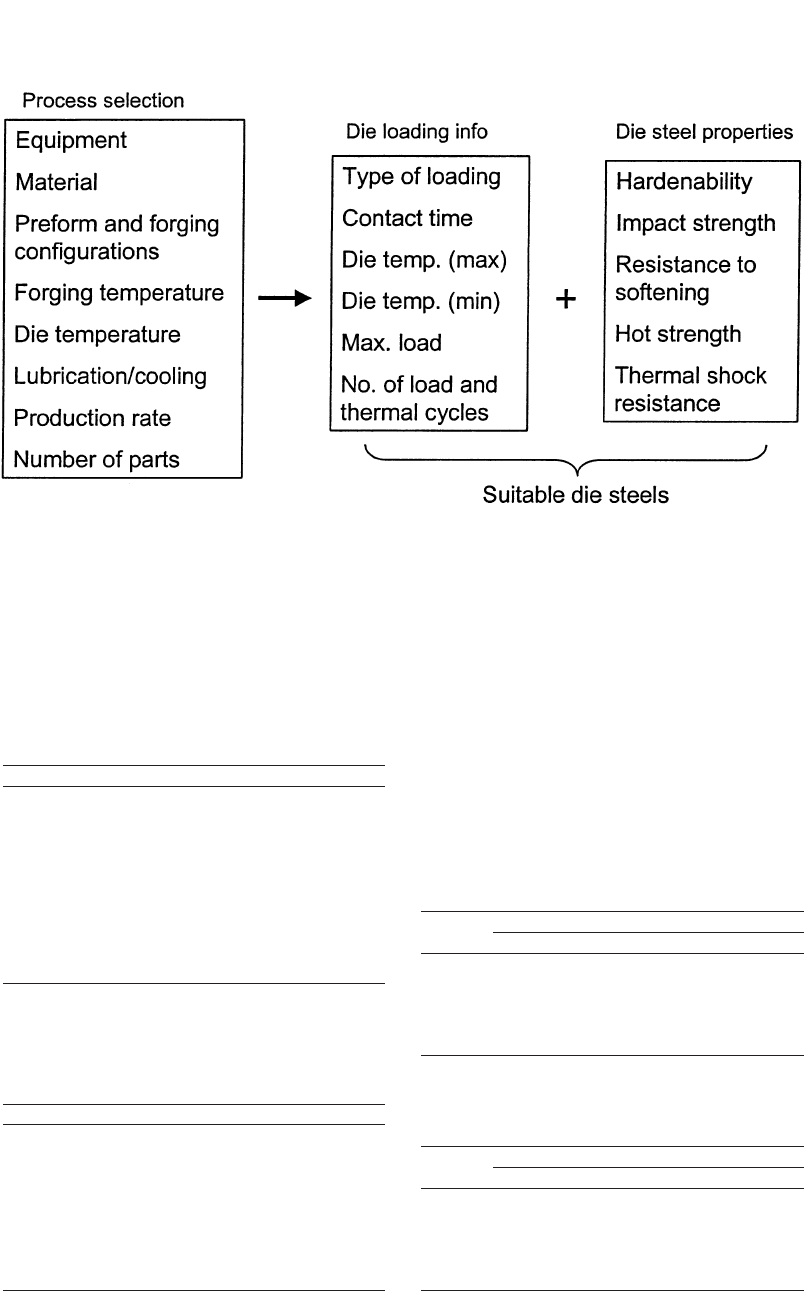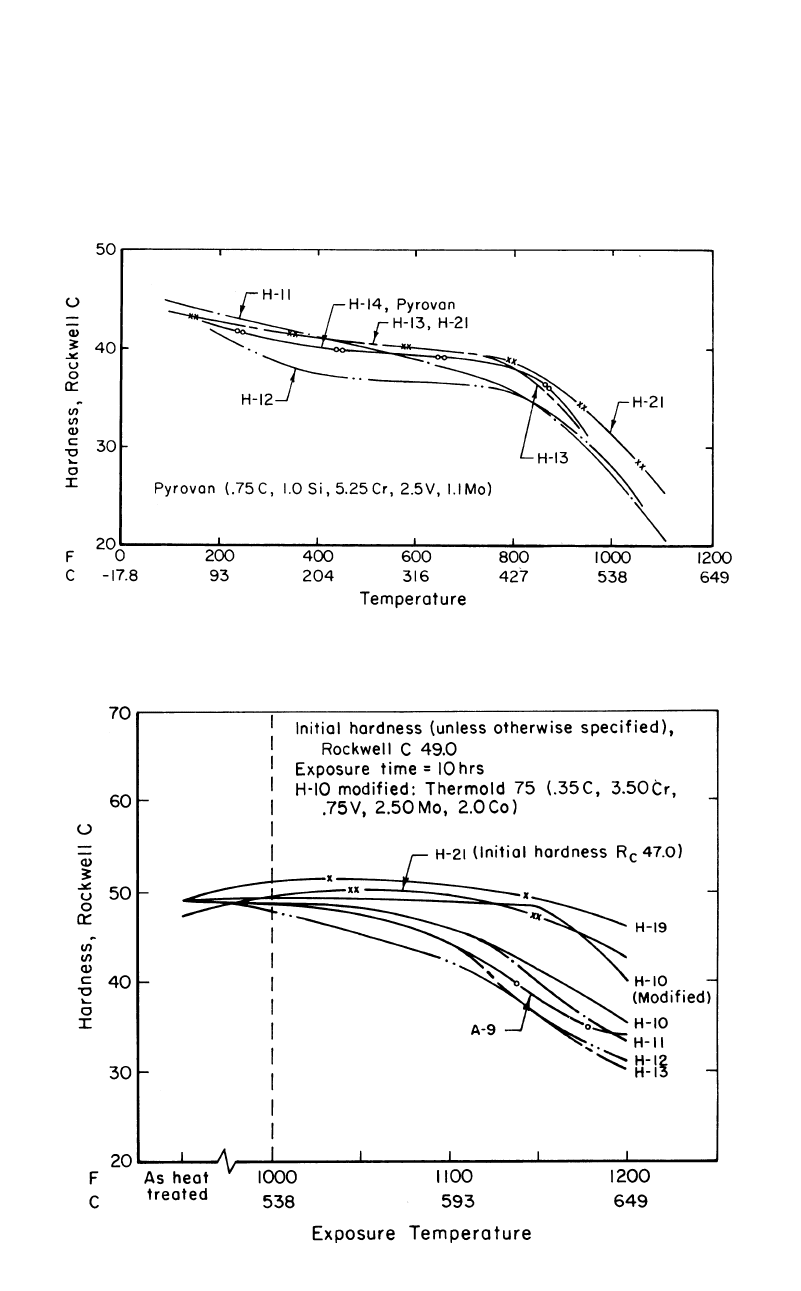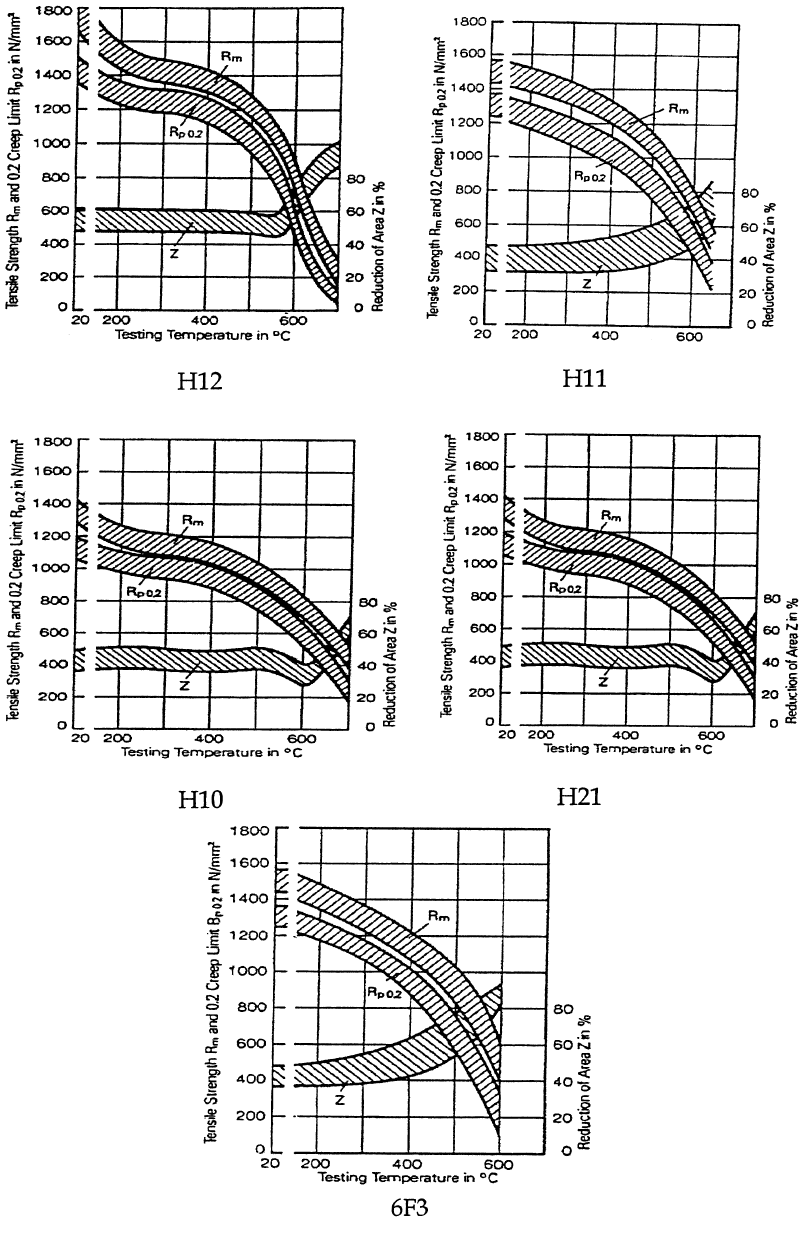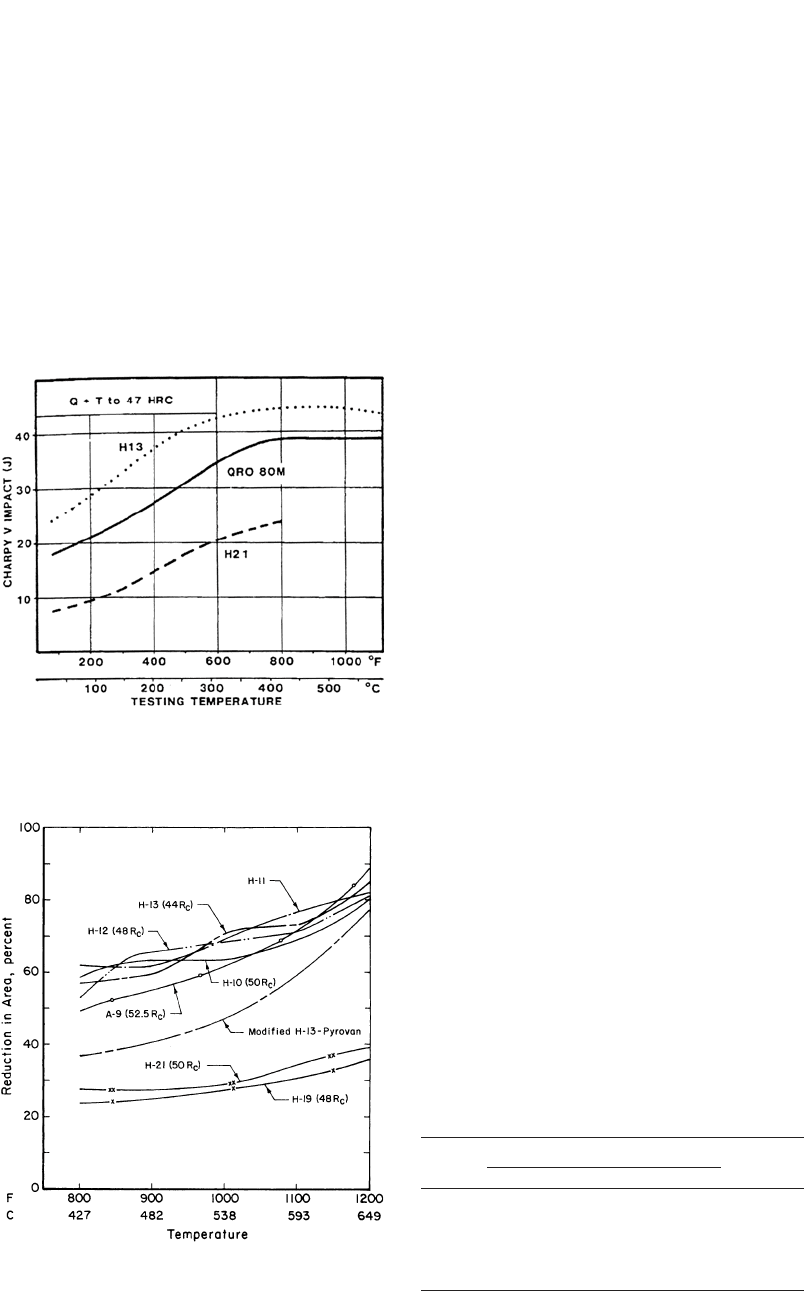Cold and Hot Forging: Fundamentals and Applications / Edited by Taylan Altan, Gracious Ngaile, Gangshu Shen
Подождите немного. Документ загружается.


CHAPTER 21
Die Materials and Die Manufacturing
Prashant Mangukia
21.1 Introduction
The design and manufacture of dies and the
selection of the die materials are very important
in the production of discrete parts by forging.
The dies must be made by modern methods from
appropriate die materials in order to provide ac-
ceptable die life at a reasonable cost. Often, the
economic success of a forging process depends
on die life and die costs per piece produced. For
a given application, selection of the appropriate
die material depends on three variables [Altan et
al., 1983]:
●
Variables related to the process itself, includ-
ing factors such as size of the die cavity, type
of machine used, deformation speed, initial
stock size and temperature, die temperature
to be used, lubrication, production rate, and
number of parts to be produced
●
Variables related to the type of die loading,
including speed of loading, i.e., impact or
gradual contact time between dies and de-
forming metal (this contact time is especially
important in hot forging), maximum load
and pressure on the dies, maximum and min-
imum die temperatures, and number of load-
ing cycles to which dies will be subjected
●
Mechanical properties of the die material, in-
cluding hardenability, impact strength, hot
strength (if hot forming is considered), and
resistance to thermal and mechanical fatigue
These factors are summarized in Fig. 21.1,
primarily for hot forging applications. Proper se-
lection of the die materials and the die manufac-
turing technique determines, to a large extent,
the useful life of forming dies. Dies may have
to be replaced for a number of reasons, such as
changes in dimensions due to wear or plastic
deformation, determination of the surface finish,
breakdown of lubrication, and cracking or
breakage. Classification of tool steels by the
American Iron and Steel Institute (AISI) is pre-
sented in Table 21.1.
21.2 Die and Tool
Materials for Hot Forging
Table 21.2 provides a good summary of cer-
tain material properties of dies for hot forging
and the corresponding failure mechanisms that
they affect.
Die materials commonly used for hot forging
can be grouped in terms of alloy content; these
materials are listed in Tables 21.3 through 21.5.
Low-alloy steels are listed in Table 21.3. Steels
with ASM designations 6G, 6F2, and 6F3 pos-
sess good toughness and shock-resistance qual-
ities, with reasonable resistance to abrasion and
heat checking. However, these steels are tem-
pered at relatively low temperatures, for exam-
ple, die holders for hot forging or hammer die
blocks. Low-alloy steels with higher (2 to 4%)
nickel contents, with ASM designations 6F5 and
6F7, have higher hardenability and toughness
and can be used in more severe applications than
steels 6G, 6F2, and 6F3. The precipitation-hard-
ening steel 6F4 can be hardened by a simple
aging operation (950 to 1050 F, or 510 to 565
C) without any cracking or distortion. In hot
forging in presses, heat transfer from the hot
stock to the dies causes this steel to harden and
become more abrasion resistant.
Hot work die steels are used at temperatures
of 600 to 1200 F (315 to 650 C) and contain
Cold and Hot Forging Fundamentals and Applications
Taylan Altan, Gracious Ngaile, Gangshu Shen, editors, p277-293
DOI:10.1361/chff2005p277
Copyright © 2005 ASM International®
All rights reserved.
www.asminternational.org

278 / Cold and Hot Forging: Fundamentals and Applications
Table 21.3 Low-alloy steels for hot forging
[Altan et al., 1983]
Designation
Nominal composition, %
(ASM) C Mn Si Co Cr Mo Ni V W
6G 0.55 0.80 0.25 . . . 1.00 0.45 . . . 0.10 . . .
6F2 0.55 0.75 0.25 . . . 1.00 0.30 1.00 0.10 . . .
6F3 0.55 0.60 0.85 . . . 1.00 0.75 1.80 0.10 . . .
6F4 0.20 0.70 0.25 . . . . . . 3.35 3.00 . . . . . .
6F5 0.55 1.00 1.00 . . . 0.50 0.50 2.70 0.10 . . .
6F7 0.40 0.35 . . . . . . 1.5 0.75 4.25 . . . . . .
Table 21.2 Critical die-related factors and
corresponding properties in the die material
used in hot forging [Krishnadev et al., 1997]
Critical die-related factor Critical properties in die material
Heat checking Hot strength (hot hardness)
Tempering resistance
Toughness/ductility
Thermal expansion
Thermal conductivity
Gross cracking Toughness/ductility
Erosion Hot strength (hot hardness)
Chemical resistance
Plastic deformation Hot strength (hot hardness)
Tempering resistance
Table 21.1 AISI classification and composition
of tool steels [Krauss et al., 1998]
Group Identifying symbol
Water-hardening tool steels W
Shock-resisting tool steels S
Oil-hardening cool work tool steels O
Air-hardening, medium-alloy cold work tool
steel
A
High-carbon, high-chromium cold work tool
steels
D
Mold steels P
Hot work tool steels, chromium, tungsten, and
molybdenum
H
Tungsten high-speed tool steels T
Molybdenum high-speed tool steels M
Fig. 21.1 Factors affecting die steel selection [Nagpal et al., 1980]
chromium, tungsten, and, in some cases, vana-
dium or molybdenum or both. These elements
induce deep hardening characteristics and resis-
tance to abrasion and softening. Generally, these
steels are hardened by quenching in air or mol-
ten salt baths. The chromium-base steels contain
5% Cr. (Table 21.4). High molybdenum content
gives these steels high resistance to softening;
vanadium content increases resistance to heat
checking and abrasion. Tungsten improves
toughness and hot hardness; however, steels
containing tungsten are not resistant to thermal
shock and cannot be cooled intermittently with
water. The tungsten-base hot work steels contain
9 to 18% W (Table 21.5); they also contain 2 to
Table 21.4 Chromium-base hot work die steels
[Altan et al., 1983]
Designation
Nominal composition, %
(ASM) C Mn Si Co Cr Mo Ni V W
H10 0.40 0.40 1.00 . . . 3.30 2.50 . . . 0.50 . . .
H11 0.35 0.30 1.00 . . . 5.00 1.50 . . . 0.40 . . .
H12 0.35 0.40 1.00 . . . 5.00 1.50 . . . 0.50 1.50
H13 0.38 0.30 1.00 . . . 5.25 1.50 . . . 1.00 . . .
H14 0.40 0.35 1.00 . . . 5.00 . . . . . . . . . 5.00
H19 0.40 0.30 0.30 4.25 4.25 0.40 . . . 2.10 4.10

Die Materials and Die Manufacturing / 279
Table 21.6 Approximate relative rankings of 15 selected high-speed steels for three properties
Material evaluation Wear resistance Hot hardness Toughness
Highest T15; M15; M4; M42 T15; M15; T6; T5; M42 M2; T1; M1
Medium M3; T6; M2 (H.C.); M10 (H.C.); M7;
M2; T5
M4; T4; M3 M3; M4; M10; M10 (H.C.); M7;
M2 (H.C.)
Lowest T1; M10; T4; M1 T1; M2; M10; M1; M7; M10 (H.C.);
M2 (H.C.)
T4; T5; M42; T15; M15; T6
T, tungsten-type high-speed steels; M, molybdenum-type high-speed steels; (H.C.), high carbon
12% Cr and may have small amounts of vana-
dium. The high tungsten content provides resis-
tance to softening at high temperatures while
maintaining adequate toughness; however, it
also makes it possible to water cool these die
steels. High-speed steels, originally developed
for metal cutting, can also be used in warm or
hot forging applications. There are two types of
high-speed steels: molybdenum-type high-speed
steels, designated by the letter M, and tungsten-
type high-speed steels, designated by the letter
T (Table 21.6). These steels offer good combi-
nations of hardness, strength, and toughness at
elevated temperatures.
21.2.1 Comparisons of
Die Steels for Hot Forging
Properties of materials that determine their se-
lection as die materials for hot forging are:
●
Ability to harden uniformly
●
Wear resistance (this is the ability of a die
steel to resist the abrasive action of hot metal
during forging)
●
Resistance to plastic deformation (this is the
ability of a die steel to withstand pressure
and resist deformation under load)
●
Toughness
●
Ability to resist thermal fatigue and heat
checking
●
Ability to resist mechanical fatigue
Ability to Harden Uniformly. The higher the
hardenability, the greater the depth to which a
material can be hardened. Hardenability de-
pends on the composition of the tool steel. In
general, the higher the alloy contents of a steel,
the higher its hardenability, as measured by the
D
I
factor (in inches). The D
I
of steel is the di-
ameter of an infinitely long cylinder that would
just transform to a specific microstructure at the
center, if heat transfer during cooling were ideal,
i.e., if the surface attained the temperature of the
quenching medium instantly. A larger harden-
ability factor D
I
means that the steel will harden
to a greater depth on quenching, not that it will
have a higher hardness. For example, the ap-
proximate nominal hardenability factors D
I
(inches) for a few die steels are as follows:
ASM-6G, 15; ASM-6F2, 15; ASM-6F3, 36;
AISI-H10, 128; and AISI-H12, 88 [Altan et al.,
1983].
Wear Resistance. Wear is a gradual change
in dimensions or shape of a component caused
by corrosion, dissolution, abrasion, and removal
or transportation of the wear products. Abrasion
resulting from friction is the most important of
these mechanisms in terms of die wear. The
higher the strength and hardening of the steel
near the surface of the die, the greater its resis-
tance to abrasion. Thus, in hot forging, the die
steel should have a high hot hardness and should
retain this hardness over extended periods of ex-
posure to elevated temperatures.
Figure 21.2 shows the hot hardness of six hot
work die steels at various temperatures. All of
these steels were heat treated to about the same
initial hardness. Hardness measurements were
made after holding the specimens at testing tem-
peratures for 30 min. Except for H12, all the die
steels considered have about the same hot hard-
ness at temperatures less than about 600 F (315
C). The differences in hot hardness show up
only at temperatures above 900 F (482 C).
Figure 21.3 shows the resistance of some hot
work die steels to softening at elevated tempera-
tures for 10 h of exposure. All of these steels
have about the same initial hardness after heat
treatment. For the die steels shown, there is not
much variation in resistance to softening at tem-
Table 21.5 Tungsten-base hot work die steels
[Altan et al., 1983]
Designation
Nominal composition, %
(ASM) C Mn Si Co Cr Mo Ni V W
H21 0.30 0.30 0.30 . . . 3.50 . . . . . . 0.45 9.25
H22 0.35 0.30 0.30 . . . 2.00 . . . . . . 0.40 11.00
H23 0.30 0.30 0.30 . . . 12.00 . . . . . . 1.00 12.00
H24 0.45 0.30 0.30 . . . 3.00 . . . . . . 0.50 15.00
H25 0.25 0.30 0.30 . . . 4.0 . . . . . . 0.50 15.00
H26 0.50 0.30 0.30 . . . 4.0 . . . . . . 1.00 18.00

280 / Cold and Hot Forging: Fundamentals and Applications
Fig. 21.3
Resistance of hot work die steels to softening during elevated-temperature exposure as measured by room-temperature
hardness. Courtesy of Universal Cyclops Steel Corp.
Fig. 21.2
Hot hardness of hot work die steels (measurements made after holding at testing temperature for 30 min.). Courtesy of
Latrobe Steel Co.
peratures below 1000 F (538 C). However, for
longer periods of exposure at higher tempera-
tures, high-alloy hot work steels, such as H19,
H21, and H10 modified, retain hardness better
than the medium-alloy steels such as H11.
Resistance to Plastic Deformation. As can
be seen in Fig. 21.4, the yield strengths of steel
decrease at higher temperatures. However, yield
strength is also dependent on prior heat treat-
ment, composition, and hardness. The higher the

Die Materials and Die Manufacturing / 281
Fig. 21.4
Resistance of die steels to plastic deformation at
elevated temperatures (values in parentheses in-
dicate hardness at room temperature). Courtesy of Universal Cy-
clops Steel Corp. and A. Finkl and Sons Co.
Fig. 21.5
Variation of Charpy toughness with different hard-
ness levels and testing temperatures on hot work
die steels (values in parentheses indicate hardness at room tem-
perature) [Nagpal, 1976b]
initial hardness, the greater the yield strengths at
various temperatures. In normal practice, the
level to which die steel is hardened is deter-
mined by the toughness of steel. Thus, in forging
applications, the die block is hardened to a level
at which it should have enough toughness to
avoid cracking. Figure 21.5 shows that, for the
same initial hardness, 5% Cr-Mo steels (H11,
etc.) have better hot strengths than 6F2 and 6F3
at temperatures greater than 700 F (371 C).
Tensile strength, creep properties, and toughness
of various die steels are given in Fig. 21.6 and
21.7.
Toughness is the ability of the material to ab-
sorb energy without fracture. It is a combination
of strength and ductility. It increases with in-
creasing temperature and is important in avoid-
ing brittle fracture (Fig. 21.7 and 21.8). Most
materials exhibit a ductile-to-brittle transition
temperature. To avoid immediate and cata-
strophic failure, dies must be put into service
above this temperature. Ductility, as measured
by reduction in area measured in a tensile test,
also increases with temperature (Fig. 21.8).
Figure 21.8 shows the ductility of various hot
work steels at elevated temperatures, as mea-
sured by percent reduction in area of a specimen
before fracture in a standard tensile test. As the
curves show, high-alloy hot work steels, such as
H19 and H21, have less ductility than medium-
alloy hot work steels such as H11. This explains
why H19 and H21 have lower toughness than
that of H11.
Fracture toughness and resistance to shock
loading are often measured by a notched-bar
Charpy test. This test measures the amount of
energy absorbed in introducing and propagating
fracture, or toughness, of a material at high rates
of deformation (impact loading). Figure 21.5
shows the results of V-notch Charpy tests on
some die steels. The data show that toughness
decreases as the alloy content increases. Me-
dium-alloy steels such as H11, H12, and H13
have better resistance to brittle fracture in com-
parison with H14, H19, and H21, which have
higher alloy contents. Increasing the hardness of
the steel lowers its impact strength, as shown by
data on 6F7 steel hardened to two different lev-
els. On the other hand, wear resistance and hot
strength decrease with decreasing hardness.
Thus, a compromise is made in actual practice,
and dies are tempered to near-maximum hard-

Fig. 21.6 Tensile strength and ductility versus test temperatures for selected die materials [Thyssen]

Die Materials and Die Manufacturing / 283
Fig. 21.8
Ductility of various die steels at high temperatures
[Nagpal, 1976a]
Fig. 21.7
Comparison of toughness properties for H13, H21,
and a new hot work tool steel, QRO80M, in func-
tion of test temperature [Johansson et al., 1985]
Table 21.7 Thermal conductivities of different
hot work die steels [Kesavapandian et al., 2001]
Composition, wt%
Thermal
conductivity,
Alloy No. C Cr Mo V W Co W/cm • K
2581 0.30 2.65 . . . 0.35 8.50 . . . 0.23
2662 0.30 2.30 . . . 0.25 8.50 2.0 0.26
2567 0.30 2.35 . . . 0.60 4.25 . . . 0.27
2365 0.32 3.00 2.80 0.55 . . . . . . 0.32
2344 0.40 5.30 1.30 1.00 . . . . . . 0.33
2343 0.38 5.30 1.10 0.40 . . . . . . 0.34
ness levels, at which they have sufficient tough-
ness to withstand loading.
The data shown in Fig. 21.5 also point to the
importance of preheating the dies prior to hot
forging. Steels such as H10 and H21 attain rea-
sonable toughness only at higher temperatures
and require preheating. For general-purpose
steels, such as 6F2 and 6G, preheating to a min-
imum temperature of 300 F (150 C) is rec-
ommended; for high-alloy steels, such as H14,
H19, and 6F4, a higher preheating temperature
of 480 F (250 C) has been recommended [Al-
tan et al., 1983].
Resistance to Heat Checking. Nonuniform
expansion, caused by thermal gradients from the
surface to the center of a die, is the chief factor
contributing to heat checking. Therefore, a ma-
terial with high thermal conductivity will make
dies less prone to heat checking by conducting
heat rapidly away from the heat surface, reduc-
ing surface-to-center temperature gradients. The
magnitudes of thermal stresses caused by non-
uniform expansion or temperature gradients also
depend on the coefficient of thermal expansion
of the steel: the higher the coefficient of thermal
expansion, the greater the stresses. Thermal con-
ductivities for some hot working steels are given
in Table 21.7. From tests in which the tempera-
ture of the specimen fluctuated between 1200 F
(650 C) and the water-quench bath temperature,
it was determined that H10 was slightly more
resistant to heat checking or cracking, after 1740
cycles, compared with H11, H12, and H13. Af-
ter 3488 cycles, H10 exhibited significantly
more resistance to cracking than did H11, H12,
and H13.
In Table 21.8, die materials are rated relative
to each other on resistance to wear, resistance to
thermal shrinking, impact toughness, and har-
denability. Comparison of die materials based on
material property and their response to surface
treatments is listed in Table 21.9.
21.2.2 Maraging Steels
Maraging steels are steels that have high
nickel, cobalt, and molybdenum content but
very little carbon. These steels are mostly used
in die casting and very rarely in forging. Some
of the compositions, of common maraging steels
are given in Table 21.10.
21.2.3 Superalloys
Superalloys are based on nickel, cobalt, and
iron. They are resistant to thermal softening.

284 / Cold and Hot Forging: Fundamentals and Applications
Table 21.10 Composition of common maraging steels [Kesavapandian et al., 2001]
Composition, wt%
Type Ni Co Mo Ti Al C Si Mn S P
I-VascoMax C-200 18.5 8.5 3.25 0.2 0.1 0.03 0.1 0.1 0.1 0.1
II-VascoMax C-250 18.5 7.5 4.8 0.4 0.1 0.03 0.1 0.1 0.1 0.1
III-VascoMax C-300 18.5 9.0 4.8 0.6 0.1 0.03 0.1 0.1 0.1 0.1
IV-VascoMax C-350 18.0 11.8 4.6 1.35 0.1 0.03 0.1 0.1 0.1 0.1
HWM 2.0 11.0 7.5 . . . . . . 0.05 0.1 0.1 0.1 0.1
X2NiCoMoTi1288Thyrotherm 2799 12.0 8.0 8.0 0.5 0.5 0.03 0.1 0.1 0.1 0.1
Marlock (Cr 0.2) 18.0 11.0 5.0 0.3 . . . 0.01 . . . 0.1 0.01 0.01
Table 21.9 Relative ranking of die materials and their response to surface engineering [Krishnadev
et al., 1997]
Material
Impact
toughness Hot hardness
Resistance to
die softening
Thermal checking
resistance Wear resistance
Resistance to surface
engineering(a)
H13 Medium Medium Medium High Medium Ion nitriding, laser, PFS, PVD, TD-VC
ORVAR Supreme High Medium Medium High Medium Ion nitriding, laser, PFS, PVD, TD-VC
QRO Supreme High High High Very high Medium Ion nitriding, laser, PFS, PVD, TD-VC
AerMet 100 Very high Low Low NA Medium Laser, PFS, PVD, TD-VC
Matrix 11 Medium Very high Very high Very high Medium Ion nitriding, laser, PFS, PVD, TD-VC
D2 Low NA NA NA High Ion nitriding, PFS, PVD, TD-VC
(a) PFS, powder flame spray; PVD, physical vapor deposition; TD-VC, thermal diffusion-vanadium carbide
Table 21.8 Comparative properties for the selection and use of die steels [Nagpal et al., 1980]
Material Relative wear resistance Relative resistance to thermal shrinking Relative impact strength (toughness) Relative hardenability
6C | |||||||
6F2 |
|||||||
6F3 |
|||||||
6F4 |
|| |||
6F5 |
|||||
6F7 |
|||||
H10 |
|| |||| |
H11 |
|||||| |
H12 |
|| |||| |
H13 |
|| |||| |
A8 |
|| |||
A9 |
|||||
6H2 |
|| |||
6H1 |
|||||
H14 |
|| |||
H19 |
|| |||
H21 |
|| |||
H26 |
|| |||
Their strength is due to the precipitation
strengthening of intermetallic compounds. Thus,
these materials are used in selected forging ap-
plications even though they are expensive.
Superalloys are of four types, namely:
●
Iron-base alloys comprise die materials such
as H46 and Inconel 706 and contain over
12% Cr. They also contain molybdenum and
tungsten to provide the matrix with high-
temperature strength. Iron-base superalloys
also include austenitic steels with high chro-
mium and nickel content. These dies can be
used up to a temperature of 1200 F (650 C).
●
Nickel-iron-base alloys contain 25 to 27%
Ni, 10 to 15% Cr, and 50 to 60% Fe, with
small quantities of molybdenum, titanium,
and vanadium. The carbon content in these
alloys is very low.
●
Nickel-base alloys contain 50 to 80% Ni,
20% Cr, and a combination of molybdenum,
aluminum, tungsten, cobalt, and niobium
(Waspalloy, Udimet 500, and Inconel 718).
The iron content is very low in these types
of alloys. These alloys can be put in service
up to a temperature of 2200 F (1205 C).
●
Cobalt-base alloys are primarily made up of
nickel, iron, chromium, tungsten, and cobalt.
These alloys are more ductile and can be
used up to a temperature of 1900 F (1040
C). Selected properties of various superal-

Die Materials and Die Manufacturing / 285
loys are given in the literature [Semiatin et
al., 1981].
21.2.4 Ceramic Dies
Some of the newer nonferrous alloys have
marked improvements over the traditional die
materials (Cr-Mo-V-base steels) used in hot forg-
ing. For example, Nissan Motor Co. is using cer-
met dies in extrusion [Kesavapandian et al.,
2001]. The material is composed of MoB (ce-
ramic) and nickel (metal.) Boron improves resis-
tance to oxidation at high temperatures. The ma-
terial is powder formed and sintered. Die life
improvements over traditional materials is 2 to 1.
Hot forging wear tests [Bramley et al., 1989]
compare silicon-base ceramics to conventional
die steels. Silicon-base ceramics exhibit far less
wear than the conventional die steels. These ma-
terials are very pure, with fine grains and uni-
form microstructures. They have high hardness,
strength, and resistance to mechanical and ther-
mal shock. However, these materials are brittle
and must not be subjected to tensile stresses; in
addition, they are expensive. Therefore, they are
used only in selected applications.
21.2.5 Nickel Aluminides
Nickel aluminides are attractive because they
derive their strength from their ordered micro-
structure instead of heat treatments. Their yield
strength increases with temperature up to about
1560 F (850 C), and they have excellent resis-
tance to oxidation up to 1830 F (1000 C). In-
formation on the composition and properties of
various nickel aluminides is available in the lit-
erature.
[Maddox et al., 1997] documented the results
of a series of performance tests between the
nickel aluminide alloys 221M-T and more tra-
ditional die steels. Whereas H11 and H13 lose
strength and hardness above 1000 F (540 C),
nickel aluminide alloys have improved high-
temperature strength, oxidation resistance, and
thermal stability at temperatures ranging from
1500 to 2300 F (815 to 1260 C). The compo-
sition of this alloy is Ni
3
Al, with additions of
chromium for ductility and resistance to oxida-
tion; molybdenum for strength; zirconium for
strength, resistance to oxidation, weldability,
and castability; and boron for ductility. The alloy
is stronger than Inconel 718 in both tension and
compression. The results of the performance test
are impressive for the nickel aluminide die ma-
terial. For the particular part being forged (at
2300 F, or 1260 C), conventional dies typically
failed after 5000 parts due to erosion, whereas
the nickel aluminide dies lasted for 35,000 parts
(a sevenfold increase). After resinking the cav-
ity, the nickel aluminide dies lasted for 50,000
parts (a tenfold increase). Hardness in the flash
actually also went up due to work hardening.
This alloy keeps its hardness at high tempera-
tures from the cast microstructure and not
through a thermal treatment. Also important is
that, while heat checking was detected in the
dies, it was not important, because of the high
ductility of the material.
21.3 Heat Treatment
Heat treatment of die steels involves the fol-
lowing steps:
1. Austenitizing temperature of a hot work tool
steel ranges from 1830 to 2730 F (1000 to
1500 C). During this phase, the structure of
steel transforms from a ferrite-pearlite struc-
ture to austenite. The dies are held at these
temperatures for a long time, which is called
a “soak” or “hold” time, to convert the entire
structure uniformly to austenite. Carbides or
alloying elements go into solution [Krauss et
al., 1998 and Kesavapandian et al., 2001].
2. After soaking, the dies are quenched in a
quench medium to a temperature below the
transformation temperature. Based on the
cooling rate, the die transforms into different
phases. Martensite is the ideal final structure,
but lower bainite, upper bainite, pearlite, or
retained austenite can be present in the struc-
ture.
3. During tempering, the martensite is tempered
to a tougher structure. This can be done in
several stages to maximize toughness with-
out reducing hardness.
Hardening and tempering temperatures for
various tool steels are available in literature and
from die steel suppliers [Roberts et al., 1980].
21.4 Die and Tool
Materials for Cold Forging
The tooling for cold forging is described in
Chapter 17, “Cold and Warm Forging,” in this
book. The back or pressure plates, which must
have high compressive strength, are made from

286 / Cold and Hot Forging: Fundamentals and Applications
Table 21.14 Steels for shrink rings [Lange,
1976]
Designation (AISI) Required hardness, HB
H13 470 to 530
440 to 510
330 to 390
4340 330 to 390
270 to 330
4140 270 to 330
Table 21.13 Tool steels and tungsten carbides
for die inserts [Lange, 1976]
Tool steels
Tungsten carbides
Designation
(AISI)
Required
hardness,
HRC Co, wt%
Density,
g/cm
3
Hardness,
DPH
D2 60 to 62 25 to 30 13.1 to 12.5 950 to 750
M2 60 to 64 18 to 42 13.6 to 13.2 1050 to 950
15 to 18 14.0 to 13.7 1200 to 1100
Table 21.12 Tool steels for cold extrusion
punches [Lange, 1976]
Required
strength
Tool steel
ksi MPa Designation (AISI) Required hardness, HRC
Forward extrusion
300 2100 M2 62 to 64
285 2000 D2 60 to 62
O1 60 to 62
230 1600 S1 56 to 58
Backward extrusion
315 2200 M4 63 to 65
300 2100 M2 62 to 64
285 2000 D2 60 to 62
Table 21.11 Tool steels for pressure plates
[Lange, 1976]
Required
strength
Designation
Required hardness
ksi MPa (AISI) HRC HB
240 1700 A2 58 to 62 . . .
D2 58 to 62 . . .
D3 58 to 62 . . .
O1 58 to 61 . . .
200 1400 H13 50 to 54 . . .
O1 50 to 54 . . .
155 1100 A8 40 to 44 . . .
O1 40 to 44 . . .
100 700 4340 . . . 270 to 330
4140 . . . 270 to 330
Table 21.15 Tool steels for counterpunches
and ejectors [Lange, 1976]
Designation (AISI) Required hardness, HB
M2 62 to 64
D2 60 to 62
A2 60 to 62
O1 60 to 62
S1 56 to 58
steels hardened up to 62 HRC, as given in Table
21.11. Selection of the punch material depends
on the type of deformation. For example, in for-
ward extrusion, the punch material must have
high compressive strength, whereas in backward
extrusion, the punch must also have very good
wear resistance, as a considerable amount of
metal flow occurs along the punch surface. Cold
work steels are a class of tool steels in which the
surface temperature does not exceed 390 F (200
C) during use. These steels offer high hardness,
good toughness, and good resistance to shock,
pressure, or wear. The subdivisions of this class
are water-hardened steels, medium-and high-al-
loyed cold-worked steels, and high-carbon chro-
mium steels. Tool steels commonly used for cold
forging punches are given in Table 21.12. The
dies are subjected to high cycling pressure as
well as abrasion. Therefore, die materials must
have high fatigue strength and good resistance
to wear (Table 21.13). In cold extrusion, the die
inserts are prestressed with one or two shrink
rings so that they can withstand the high stresses
present in the die cavity. Materials suitable for
shrink rings are given in Table 21.14. Tool steels
used for ejectors and counterpunches are given
in Table 21.15 [Lange, 1976]. Table 21.16 gives
the relative performance of different cold forg-
ing tools.
The special-purpose steels are the materials
that cannot be classified as either cold-worked
or high-speed steels. They are required when
certain properties are particularly important,
such as corrosion resistance. Hardenable hard
materials are a class between high-speed steels
and carbides. They have good machinability, as
long as they have not been hardened, and a very
high resistance to wear in the hardened state.
They are used to form very large cold forgings
[ICFG, 1992].
21.4.1 Cemented Carbide
Cemented carbides are composite materials
consisting of hard, wear-resistant material in a
more ductile metallic matrix. The two elements
are formed into one through a sintering process.
Tungsten carbide, which consists of tungsten in
a cobalt matrix, is typical in tool and die appli-
cations.
As manufacturing processes have improved,
the use of tungsten and other cemented carbides
